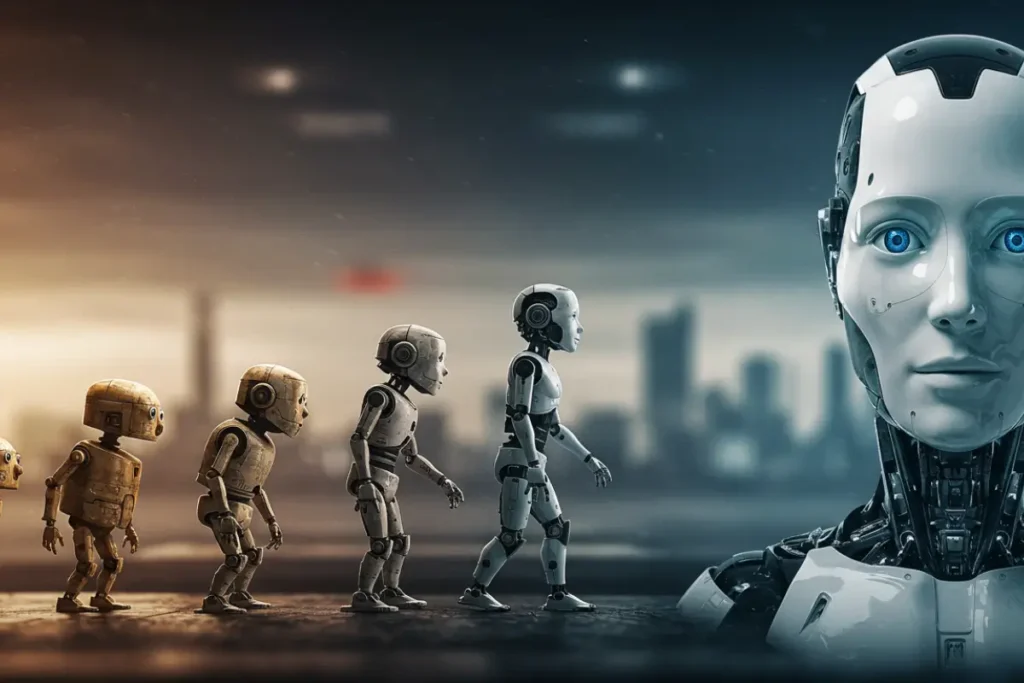The Evolution of AI-Powered Robots
- April 22, 2025
- 0
Introduction: The Age of AI-Powered Robots is Here 🌍 Imagine waking up one day and realizing your best friend, co-worker, or even your doctor… is a robot. Sounds
Introduction: The Age of AI-Powered Robots is Here 🌍 Imagine waking up one day and realizing your best friend, co-worker, or even your doctor… is a robot. Sounds

Imagine waking up one day and realizing your best friend, co-worker, or even your doctor… is a robot. Sounds like science fiction, right? Well, welcome to the future.
The rise of AI-powered robots has been one of the most thrilling transformations in modern history. These intelligent machines are no longer confined to labs or Hollywood films.
They’re among us—helping, learning, adapting, and evolving faster than ever.
From clunky metal arms to robots with faces and emotions, the journey of AI in robotics has been mind-blowing. And the best part? We’re just getting started.
This article takes you through the massive evolution of AI-powered robots, why they matter, where they’re heading, and how they’re shaping our world.
Also, check out this article that dives deep into another aspect of our tech future 👉 The Rise of AI-Powered Supercomputers.

Once upon a time, robots were nothing more than machines that followed basic instructions. Think of early factory bots—they could weld, lift, or sort objects, but they couldn’t think or react.
But then came Artificial Intelligence (AI), and that changed everything. Suddenly, robots could do more than just obey—they could learn, adapt, and even interact with humans in real time. That’s a huge leap!
Let’s take a quick look at the main stages of this robotic evolution:
Want to know more about AI in space? 🌌 Check this: The Future of AI in Space Exploration
Today, AI-powered robots are everywhere—and their roles are growing rapidly. Let’s look at where you might already see these smart machines in action:
Check out this in-depth review on personal AI robots!

You might be wondering: how can a machine think, feel, or respond? Great question! Let’s break it down:
This is how robots learn from data. They analyze patterns and make predictions. For example, if a robot vacuum sees a chair 100 times, it learns to avoid it automatically.
Robots can see and interpret the world using cameras and sensors. They don’t just “look”—they understand what they’re seeing.
Thanks to NLP, robots can understand human language, respond to it, and even mimic speech patterns. That’s how your phone’s voice assistant works.
It’s like training a puppy! Robots are rewarded for good behavior and penalized for mistakes, helping them learn smarter behavior over time.
Want more nerdy insights? 😄 See this Wikipedia article on Artificial Intelligence.
With great power comes great responsibility. As robots become more human-like, we must ask: should they have rights? Should they make decisions for us? These are tough but important questions.
Some big ethical issues include:
We’re entering new territory, and governments, developers, and society must work together to make sure these machines help, not harm.

Okay, now for the fun part—where is all this heading? Here’s what experts think will happen next:
Some even predict that humans and robots will become integrated—with AI-enhanced brains, bodies, and perhaps even digital consciousness.
Don’t miss our deep article on AI and the Evolution of Human Consciousness for more insights!
We’ve come a long way from gears and wires to intelligent machines that learn and care. As we step deeper into this futuristic world, it’s clear that AI-powered robots are here to stay—and they’re only going to get smarter.
But with that comes responsibility. We must ensure that their power is used for good, equality, and progress.
👉 If you enjoyed this article, don’t forget to share it with your friends or drop a comment below! Let’s talk robots! 🤖🧠
Created with passion for the future by Futuristic Intellect ✨